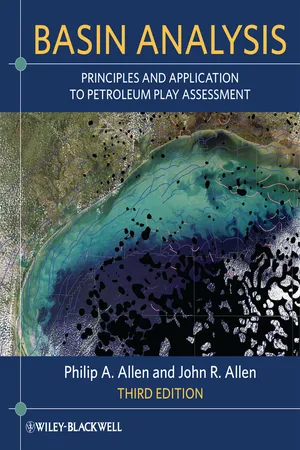
Basin Analysis
Principles and Application to Petroleum Play Assessment
- English
- ePUB (mobile friendly)
- Available on iOS & Android
About this book
Basin Analysis is an advanced undergraduate and postgraduate text aimed at understanding sedimentary basins as geodynamic entities. The rationale of the book is that knowledge of the basic principles of the thermo-mechanical behaviour of the lithosphere, the dynamics of the mantle, and the functioning of sediment routing systems provides a sound background for studying sedimentary basins, and is a pre-requisite for the exploitation of resources contained in their sedimentary rocks. The third edition incorporates new developments in the burgeoning field of basin analysis while retaining the successful structure and overall philosophy of the first two editions.
The text is divided into 4 parts that establish the geodynamical environment for sedimentary basins and the physical state of the lithosphere, followed by a coverage of the mechanics of basin formation, an integrated analysis of the controls on the basin-fill and its burial and thermal history, and concludes with an application of basin analysis principles in petroleum play assessment, including a discussion of unconventional hydrocarbon plays. The text is richly supplemented by Appendices providing mathematical derivations of a wide range of processes affecting the formation of basins and their sedimentary fills. Many of these Appendices include practical exercises that give the reader hands-on experience of quantitative solutions to important basin analysis processes.
Now in full colour and a larger format, this third edition is a comprehensive update and expansion of the previous editions, and represents a rigorous yet accessible guide to problem solving in this most integrative of geoscientific disciplines.
Additional resources for this book can be found at: www.wiley.com/go/allen/basinanalysis.
Frequently asked questions
- Essential is ideal for learners and professionals who enjoy exploring a wide range of subjects. Access the Essential Library with 800,000+ trusted titles and best-sellers across business, personal growth, and the humanities. Includes unlimited reading time and Standard Read Aloud voice.
- Complete: Perfect for advanced learners and researchers needing full, unrestricted access. Unlock 1.4M+ books across hundreds of subjects, including academic and specialized titles. The Complete Plan also includes advanced features like Premium Read Aloud and Research Assistant.
Please note we cannot support devices running on iOS 13 and Android 7 or earlier. Learn more about using the app.
Information
- Isostatic consequences of changes in crustal/lithospheric thickness, such as caused mechanically by lithospheric stretching, or purely thermally, as in the cooling of previously upwelled asthenosphere in regions of lithospheric stretching.
- Loading (and unloading) of the lithosphere causes a deflection or flexural deformation and therefore subsidence (and uplift), as in foreland basins.
- Viscous flow of the mantle causes non-permanent subsidence/uplift known as dynamic topography, which can most easily be recognised in the domal uplifts of the ocean floor at volcanic hotspots.
1.1 Introduction and Rationale



Table of contents
- Cover
- Title page
- Copyright page
- Companion website details
- Preface to the third edition
- PART 1: The foundations of sedimentary basins
- PART 2: The mechanics of sedimentary basin formation
- PART 3: The sedimentary basin-fill
- PART 4: Application to petroleum play assessment
- Appendices: derivations and practical exercises
- References
- Index